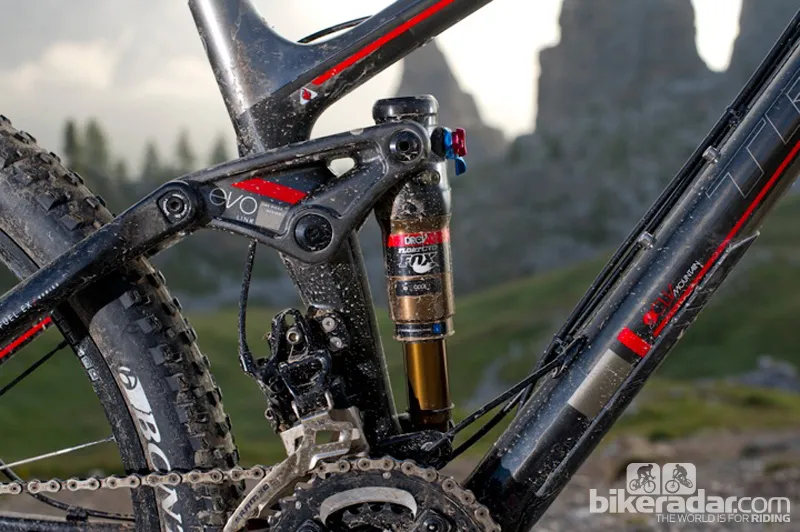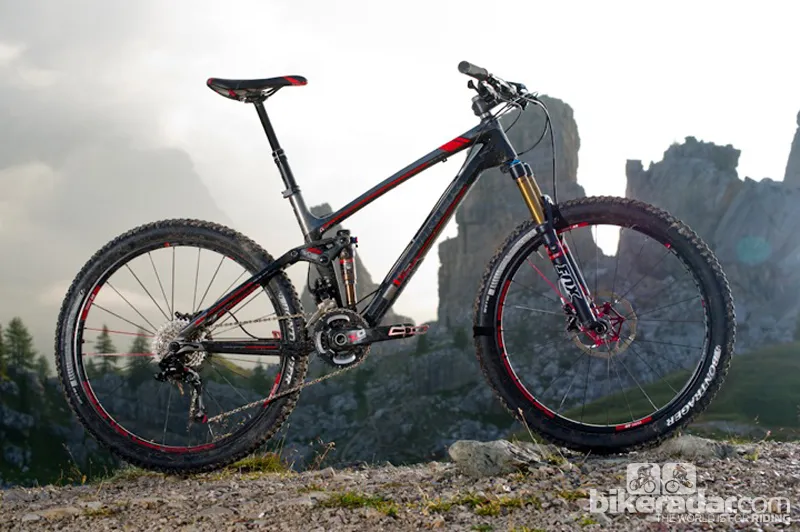When it comes to trail bikes, Trek’s steadily evolving Fuel EX range has largely been seen as one that hits above its weight in the 120mm travel category. But times change and so do riders’ demands, not least when it comes to the amount of travel front and rear.
And Trek are listening. For 2013 we’re getting a 130mm travel Fuel EX that, while hinting more at evolution than proposing revolution, delivers a stunning performance out on the trail.
Ride & handling: responsive, agile and tack-sharp
We put the flagship Fuel EX 9.9 through its paces on the steep, loose, lively trails around Cortina d’Ampezzo in the Italian Dolomites. Safe to say we came away happy and, just as importantly, largely unscathed.
Last year’s tweaks to the Fuel EX range brought a welcome slackening of the head-angle to 68 degrees. Combined with Trek’s proprietary and effective DRCV (Dual Rate Control Valve) technology in front and rear shocks, this offered the bike a sniff at its true trail potential. As such it was hard to see where it could go without perhaps dabbling in little-plumbed 650b wheel territory for 2013, but in its new, slightly longer travel guise this 26er appears reason enough to stay with ‘small’ wheels in the trailbike category.
Pointing it downhill over the kind of rock-strewn trail that is typically seen as big brother Remedy's terrain, we found the new EX 9.9 more than capable. While the drop-offs and vertical rollovers hidden among a sea of less-than-forgiving sharp limestone had us wishing for a tiny bit slacker head-angle at times, we soon learned to trust the bike’s capabilities, sit back and let it roll.
The 9.9 proved compliant over anything that was thrown at it, while retaining a firm grasp on its tack-sharp handling. Certainly the DRCV technology helps by propping up the ride for increased responsiveness and agility among the small bumps while simultaneously holding big-hit swallowing performance in reserve, but we couldn’t help feel that the extra 10mm of travel wielded by the new EX 9.9 added more than a mere 10mm should in terms of confidence building.
The 9.9’s handling has finesse when it gets demanding. This bike just feels right in the tight stuff.
Control was helped by 720mm wide, low rise bars and an über-light frame – and the resultant stiff, direct package enabled the 9.9 to easily hop over obstacles and pivot around switchbacks. At speed, descending off the saddle, the bike feels low and stable, while climbs feel efficient with oodles of traction.
We found little use for the ‘climb’ mode on the new Fox CTD damper though, the ride becoming too harsh on anything other than stretches of tarmac when in ‘climb’. In truth Trek’s ABP design manages suspension bob admirably even in the small ring, and we found leaving the fork and shock in the open ‘descend’ mode worked fine for most trail applications, across or down, switching to ‘trail’ for rough, rocky jeep track climbs.
If you like to completely eradicate inefficient suspension movement then the ‘climb’ mode will appeal, but you’ll pay the price with less comfort and less traction on the loose terrain. While the fork is smooth and plush on the small hits, we’d like to drop in the new Trek DRCV spacers to see if we can add a little more ‘ramp up’ in the fork for the kind of rugged but playful descents we encountered in the Dolomites, and love the idea that the rider has access to that kind of tunability.

Chain-slap was as good as forgotten with the Type 2 rear derailleur; the EX comes fitted with a decent rubber chainstay protector with a downward sharkfin that keeps any remaining trail clatter to a minimum on bouncy descents. The new X0 Trail brakes are efficient, being progressive rather than grabby, and deliver great feedback through the levers.
The lever is long enough for ‘middle finger brakers’ and we liked the tool-free reach adjust, though it’s hard to acccess with gloved hands. The organic pads squealed like hell when wet after a thunder and hail storm dousing.
In the wet was the only time we came unstuck with the new Bontrager XR3 Team Issue tyre too. While the spec sheet states 2.2in width, our test bike came with wider 2.35in tyres to give us the edge over the rock gardens we’d encounter during the three-day test.
The new XR3 tyres manage grip admirably in the rock and gravel, with predictable handling while rolling impressively fast. Heavy rain and clay-like mud left us sliding like slugs on a Teflon frying pan though, but those are the kind of conditions that challenge most tyres traction; although finding the best way was just to 'pin it' across the roots and rocks, we’d have preferred the more aggressive side knobbed Bontrager XR4 2.35in for those conditions.
Frame & equipment: sleek, well-spec'd redesign
Trek haven’t merely slipped in a longer stroke shock to achieve the new Fuel EX’s extra 10mm of travel; their designers have gone back to the drawing board for a complete redesign throughout the seven-bike range. The result is a sleeker looking frame design that incorporates a shorter, more compact magnesium EVO linkage for a more sprightly ride.
The EX 9.9 employs Trek's proprietary OCLV (Optimum Compaction Low Volume) Mountain Carbon throughout front and rear triangles to shed weight to a claimed 11.2kg (24.5lb) for the complete bike. As mentioned above, Trek have bucked the trend for slacker trail bikes and stuck with the current 68-degree head-angle on their E2 tapered headtube, but sneaking the main suspension pivot location forward has resulted in a 5mm lower sagged BB height. This helps flatten out the chain torque curve to deliver even more efficiency than we’re already used to from its ABP design.
With BB height effectively lowered, Trek have made a quick nip and tuck out back and shortened chainstay length by 5mm for increased traction and better manuoevrability on tight trails. The package is finished off with internal cable routing and at last, dropper post guides as well as ports for running a stealth dropper post hose internally. Finally ISCG 05 tabs and a removable front mech mount hint at the bike’s 1x10 potential.
Bouncing duties are taken care of by Kashima-coated Fox Factory Series Float 32 fork and rear shock, with both incorporating DRCV technology for swallowing up bigger hits. Both shock and fork sport Fox’s new CTD (Climb-Trail-Descend) three-way damping lever for idiot-proof adjustments to your ride.
While the DRCV is nothing new, an ability to user-tune the fork’s ride is for 2013. By popping off the top cap of the fork leg and dropping in one of 2 different DRCV spacer sets (either 5mm or 10mm deep), the rider can now tune the spring rate curve of their fork, from a standard linear spring to sequentially more progressive rates that should cater for more aggressive riders. Trek say this fettle is a simple ten-minute job.
The 9.9 is spec’d with a complete SRAM X0 2x10-speed set up, offering a massive gear range that will cater for any rider’s needs, anywhere, up or down hill. Trail noise is controlled by the new chainslap resisting SRAM Type 2 derailleur. Stopping it all on a button are the new 4-piston caliper Avid X0 Trail brakes.
Front QR15 thru-axle stiffness is paired with a 142x12 rear thru axle holding in place DT Swiss XM 1550 Tricon, 24-spoked, tubeless wheelsets. Rubber is the new XR3 2.2in tyre and finishing kit comes from the worthy in-house Bontrager X Lite and XXX Lite ranges.

It’s easy to think that Trek have taken a slightly conservative approach with the 2013 Fuel EX, bucking the current trend for increasingly slacker angles and not reaching out for the 140mm travel gun holster. Instead they have retained the distinct ‘singletrack trail’ identity of the Fuel EX that has won it so much acclaim.
As such it may seem like the EX 9.9 is occupying middle ground, but its redesign and extra travel deliver a bike that is very performance focused while a helluva lot of fun too.
£6250 for the EX 9.9 is a lot of money and yes you get an amazing, very capable ride. But we’re aware that for £3350 less you can have the same trail eating ability and DRCV suspension tech’ on the £2900 alu EX9, for a 1.36kg (3lb) penalty in weight.









